Frederik van Valkenborch (1566-1623) stands as a significant, if sometimes overlooked, figure in the rich tapestry of Flemish art during the late 16th and early 17th centuries. A scion of a prolific artistic dynasty, his life and work bridge the late Renaissance traditions of Northern Europe with the emerging dynamism of the Baroque. Born in Antwerp and later active in Germany, Valkenborch specialized in landscapes, often imbued with dramatic or allegorical elements, and also produced portraits. His art reflects the turbulent religious and political climate of his era, as well as the evolving artistic tastes that saw landscape painting rise to unprecedented prominence.
A Family Forged in Art and Upheaval
Frederik van Valkenborch was born into an environment steeped in artistic creation. His father was Lucas van Valckenborch the Elder (c. 1535 – 1597), a highly respected painter known for his landscapes, genre scenes, and depictions of the seasons. His uncle, Marten van Valckenborch I (1535–1612), was also a distinguished painter, and Frederik's brother, Gillis van Valkenborch (c. 1570–1622), followed the family tradition, specializing in dramatic, often fiery, landscapes and mythological scenes. The Valckenborch family, originally from Leuven in the Duchy of Brabant, were part of a wave of Protestant artists and intellectuals who sought refuge from the religious persecution and political instability in the Spanish-ruled Southern Netherlands.
This exodus was a defining feature of the period, with many Flemings migrating to more tolerant German imperial cities. The Valckenborchs were no exception. Lucas van Valckenborch, Frederik's father, left Antwerp around 1566, the year of Frederik's birth, likely due to the iconoclastic fury (Beeldenstorm) and the subsequent crackdown by the Duke of Alba. He worked in Aachen and Liège before eventually settling in Frankfurt am Main in 1593, where he became a citizen in 1594 and died in 1597. Marten van Valckenborch I also moved, eventually joining his brother Lucas in Frankfurt. This familial displacement undoubtedly shaped Frederik's worldview and provided him with a broader cultural exposure than if he had remained solely in Antwerp.
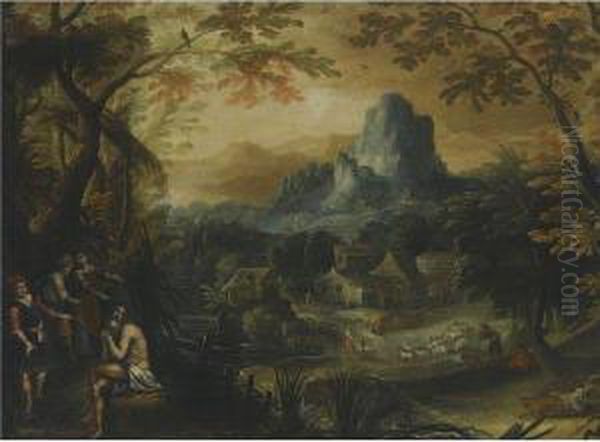
Frederik likely received his initial artistic training from his father, Lucas, whose style was characterized by detailed observation, often incorporating elements from the tradition of world landscapes pioneered by Joachim Patinir and further developed by Pieter Bruegel the Elder. The workshop environment would have been immersive, with techniques and stylistic approaches passed down directly. Frederik's early career saw him active in Antwerp, the bustling artistic and commercial hub of the Southern Netherlands, and later in Frankfurt, following in his father's footsteps. He eventually settled in Nuremberg, where he died in 1623.
Artistic Style: Bridging Tradition and Innovation
Frederik van Valkenborch's artistic output is primarily characterized by his landscape paintings, though he also engaged with portraiture. His style, while clearly indebted to the Netherlandish landscape tradition, particularly the work of Pieter Bruegel the Elder, possesses a distinct character. He often favored dramatic, sometimes fantastical, mountainscapes, forest scenes, and depictions of cataclysmic events, which distinguished him from the more serene or pastoral approaches of some contemporaries.
A key influence, as noted, was Pieter Bruegel the Elder (c. 1525–1569). Bruegel's panoramic views, his "world landscapes" that combined meticulous detail with a sense of cosmic scale, and his depictions of peasant life and seasonal cycles, left an indelible mark on subsequent generations of Flemish artists, including the Valckenborchs. Frederik adopted Bruegel's high viewpoints in many of his compositions, allowing for expansive vistas, and shared an interest in depicting human activity within the broader natural world. However, Frederik often pushed the dramatic potential of his scenes further, employing starker contrasts of light and shadow (chiaroscuro) and a more agitated, dynamic rendering of natural elements like trees, rocks, and water.
His works demonstrate a keen observation of nature, with detailed renderings of foliage, geological formations, and atmospheric effects. He utilized atmospheric perspective effectively, creating a sense of depth by gradually muting colors and softening details in the background. His palette could range from the rich, earthy tones typical of Flemish landscapes to more vibrant and sometimes fiery hues, especially in scenes depicting conflagrations or divine interventions. This dramatic use of color and light prefigures some aspects of the Baroque.
While realism was a foundational element, Frederik did not shy away from imaginative or allegorical content. His landscapes often served as settings for biblical stories, mythological episodes, or scenes of contemporary life such as annual fairs or markets, which allowed for the inclusion of numerous small figures and anecdotal details, a characteristic popular in Flemish painting.
Representative Works and Their Significance
Several works exemplify Frederik van Valkenborch's artistic concerns and stylistic traits. While some attributions remain debated, a core body of work reveals his unique contributions.
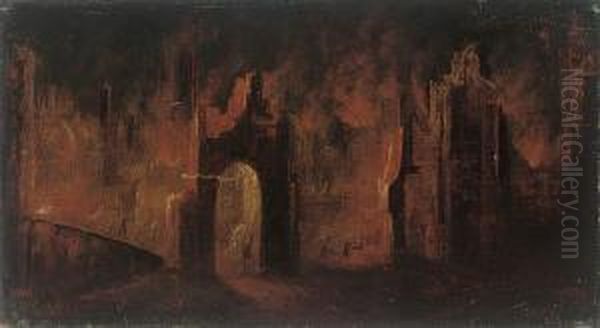
A notable example is a Mountainous Landscape (oil on panel, 27 x 35 cm), which showcases his mastery of creating dramatic, rugged terrains. The composition often features towering, craggy peaks, deep valleys, and winding paths, populated by small figures that emphasize the grandeur and wildness of nature. In such works, Valkenborch employed strong chiaroscuro to model the forms of the mountains and trees, and atmospheric perspective to convey the vastness of the scene. His use of a bold green and tonal color palette in these landscapes is characteristic, lending them a vivid, almost untamed quality. These scenes often evoke a sense of awe and sometimes a slight unease, reflecting perhaps the sublime power of nature.
Biblical and Mythological Scenes in Landscape:
Frederik frequently integrated narrative elements into his landscapes. Moses Drawing Water from the Rocks (1589, formerly Bernhagen Althaus Museum, though current location may vary) is an early example where the biblical narrative unfolds within an expansive, rocky landscape. The focus remains on the dramatic interaction between the figures and their environment. Similarly, The Deluge (1588, British Museum, London), likely a drawing or print, would have allowed him to explore themes of divine judgment and human vulnerability amidst overwhelming natural forces, a subject also tackled by his brother Gillis.
St. Jerome in Meditation is another significant work, depicting the saint in penitence within a wild, secluded landscape. This painting is noted for its strong chiaroscuro, creating a powerful, introspective mood. Art historians have noted stylistic similarities in the handling of light and landscape to the works of Paul Bril (1554–1626), a Flemish painter who spent most of his career in Rome and was highly influential in the development of landscape painting. This suggests Valkenborch was aware of, and perhaps responding to, broader European artistic currents. The work is generally dated to the late 1590s or early 1600s.
Genre Scenes and Allegories:
Like his father Lucas, Frederik also painted scenes of everyday life, such as Annual Fair or Fish Market (the latter in the Royal Museum of Fine Arts, Antwerp). These works are bustling with activity, filled with numerous figures engaged in various pursuits, offering a lively glimpse into contemporary society. They continue a tradition popularised by artists like Pieter Aertsen and Joachim Beuckelaer in the mid-16th century.
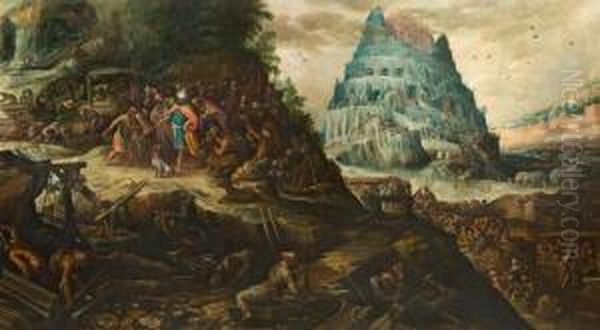
The Tower of Babel is a particularly fascinating and complex subject that Frederik, like many Netherlandish artists before and after him (including his father Lucas, his uncle Marten, and Pieter Bruegel the Elder), depicted. His rendition of this theme, often a symbol of human hubris and divine retribution, would have allowed him to showcase his skill in architectural rendering, the depiction of myriad figures engaged in labor, and the creation of a dramatic, large-scale composition. These paintings were rich in allegorical meaning, commenting on human ambition, the diversity of languages, and the power of God. Comparisons are often drawn with versions by Pieter Bruegel the Elder and Tobie Verhaecht (1561–1631), a contemporary Antwerp landscape painter known for his mountainous scenes.
The Lost Heller Altarpiece:
A testament to Frederik's reputation during his lifetime was the commission he received in 1607 from Archduke Maximilian III of Austria, a prominent Habsburg patron of the arts. Valkenborch was tasked with creating a work to replace parts of the famed Heller Altarpiece by Albrecht Dürer and Matthias Grünewald in the Dominican Church in Frankfurt, after Dürer's central panel had been sold. While Frederik's contribution to the Heller Altarpiece is now lost, the commission itself signifies the high regard in which he was held, placing him in the company of some of the most revered artists in German and Netherlandish history.
The Valckenborch Dynasty: An Artistic Ecosystem
Frederik van Valkenborch was not an isolated artist but part of a larger, interconnected family of painters. This dynastic aspect is crucial to understanding the transmission of styles, techniques, and thematic preferences in Netherlandish art.
His father, Lucas van Valckenborch the Elder, was a pivotal figure. Lucas's oeuvre includes detailed landscapes, often with seasonal themes (like his famous Tower of Babel paintings, series of the Months, and Winter Landscape), market scenes, and portraits. He served as a court painter to Archduke Matthias of Austria, governor of the Spanish Netherlands, whom he followed to Linz and then Frankfurt. Frederik's early training under Lucas would have exposed him to these themes and to the demands of courtly patronage.
Frederik's uncle, Marten van Valckenborch I, was Lucas's brother and a close artistic associate. Marten also specialized in landscapes, often with biblical or mythological scenes, and depictions of the Tower of Babel. He, too, left Antwerp, working in Mechelen, Aachen, and eventually settling in Frankfurt, where he collaborated with Lucas. His sons, Gillis van Valkenborch (Frederik's brother) and Marten van Valckenborch the Younger, continued the artistic lineage.
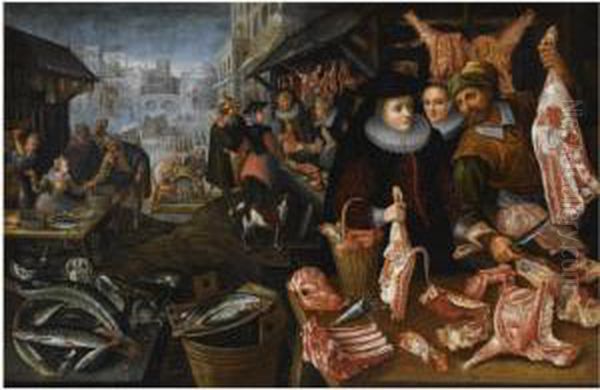
Frederik's brother, Gillis van Valkenborch, developed a particularly dramatic style, often depicting fiery scenes like the Burning of Troy or Aeneas fleeing Troy, as well as tumultuous landscapes. While sharing the family's grounding in detailed landscape, Gillis leaned towards more Mannerist exaggerations in his figures and a heightened sense of drama, often using strong contrasts and vivid, almost lurid, colors for his fire effects.
The Valckenborch family workshop, whether in Antwerp, Frankfurt, or elsewhere, would have been a collaborative environment. It's plausible that family members worked on paintings together, or that younger artists assisted their elders, leading to similarities in style and theme. This collaborative practice was common in the period and makes precise attributions for some works challenging. The family's collective output significantly contributed to the development of landscape and genre painting in both the Netherlands and Germany.
Contemporaries and the Artistic Milieu
Frederik van Valkenborch worked during a vibrant and transformative period in European art. The artistic centers of Antwerp and Frankfurt were melting pots of influences.
In Antwerp, the legacy of Pieter Bruegel the Elder loomed large. His sons, Pieter Brueghel the Younger (c. 1564–1638) and Jan Brueghel the Elder (1568–1625), were Frederik's contemporaries. Pieter the Younger largely replicated his father's successful compositions, while Jan Brueghel the Elder, known as "Velvet" Brueghel, became famous for his exquisitely detailed flower paintings and small-scale allegorical and mythological landscapes, often collaborating with figures like Peter Paul Rubens (1577–1640). While Frederik's style was more rugged than Jan Brueghel's refined manner, they shared an interest in detailed observation and the burgeoning market for landscape painting.
Other notable Antwerp landscape specialists of the time included Joos de Momper (1564–1635), known for his often fantastical mountain landscapes, continuing the world landscape tradition but with a more painterly and atmospheric approach. Tobie Verhaecht, mentioned earlier, also specialized in mountainous scenes and was Rubens's first teacher. The city was a hub for printmaking as well, with publishers like Hieronymus Cock disseminating artistic ideas widely.
The trend of Netherlandish artists traveling to Italy, or being influenced by Italian art, was strong. Paul Bril, who settled in Rome, became a leading figure in landscape painting there, influencing both Italian and Northern artists. His idealized landscapes, often with classical ruins or biblical scenes, offered a different model from the more naturalistic or dramatic styles prevalent in the North. The stylistic similarities noted between Frederik's St. Jerome and Bril's work suggest an awareness of these Italianate trends, perhaps through prints or returning artists.
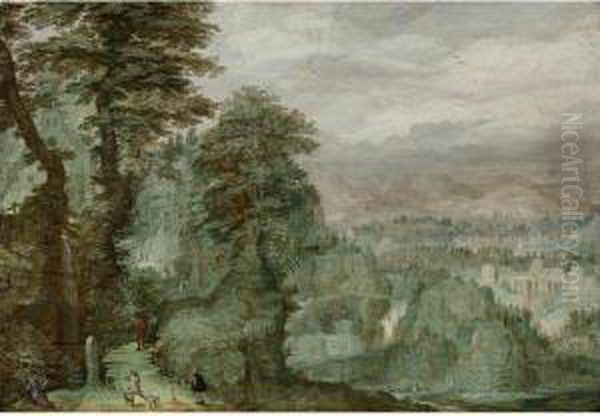
In Germany, particularly Frankfurt and later Nuremberg where Frederik settled, he would have encountered a different artistic environment. While German art had a rich tradition, the influence of Netherlandish artists was significant, especially those who, like the Valckenborchs, had migrated there. Adam Elsheimer (1578–1610), a German painter who worked primarily in Rome, was a contemporary. Elsheimer's small, meticulously detailed paintings on copper, known for their innovative use of light and poetic atmosphere, were highly influential, impacting artists like Rubens and Rembrandt. While Elsheimer's style was distinct, his focus on light and atmosphere in landscape was part of a broader European trend.
The patronage of figures like Archduke Maximilian III of Austria also played a role in shaping artistic production, favoring certain themes and styles. The Archduke's court would have been a cosmopolitan environment, exposing artists to various influences.
Controversies and Art Historical Assessment
Like many artists from earlier periods, Frederik van Valkenborch's oeuvre has been subject to art historical scrutiny, leading to discussions and sometimes debates about attributions and influence.
The authenticity and artistic merit of specific works, such as certain versions of The Tower of Babel attributed to him or his circle, can be debated. The Valckenborch family's workshop practices, where multiple members might work on similar themes or even collaborate, can complicate attributions. Distinguishing Frederik's hand from that of his father Lucas, his uncle Marten, or his brother Gillis requires careful stylistic analysis.
When comparing Frederik's Tower of Babel to that of Pieter Bruegel the Elder, Bruegel's version is generally considered the more iconic and compositionally sophisticated. However, Frederik's interpretations still offer valuable insights into how this potent biblical theme was reinterpreted by later generations, often with an emphasis on different aspects of the narrative or a different stylistic flavor.
In terms of broader artistic evaluation, Frederik van Valkenborch is generally seen as a skilled and imaginative painter who made a distinctive contribution to landscape painting. While perhaps not reaching the revolutionary status of a Pieter Bruegel the Elder or a Rubens, he was a significant transitional figure. His work embodies the late Mannerist tendencies towards drama and dynamism while retaining the detailed realism of the Northern tradition. Some might argue that his style occasionally veers towards the overly dramatic or fantastical, but this is also part of its unique appeal and reflects the tastes of the period.
The relative obscurity of his historical background compared to more famous contemporaries can sometimes lead to an underestimation of his work. However, his ability to secure prestigious commissions, like the Heller Altarpiece component, indicates he was highly regarded in his own time.
Works in Collections and on the Art Market
Works by Frederik van Valkenborch are found in several prominent museum collections, allowing for their continued study and appreciation.
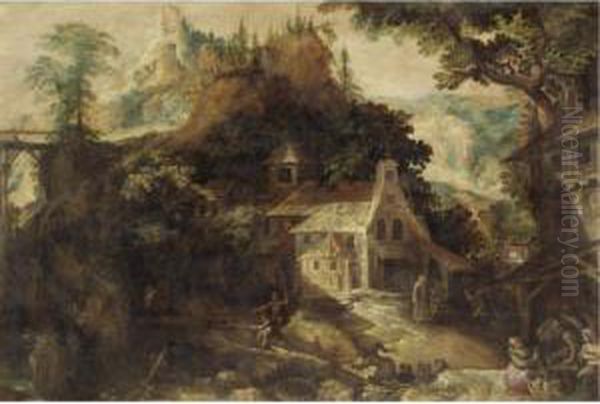
The Kunsthistorisches Museum in Vienna holds a number of his paintings, reflecting the Habsburg patronage that his family, particularly his father Lucas, enjoyed. These often include characteristic mountainous landscapes and market scenes.
The Royal Museum of Fine Arts in Antwerp possesses works such as his Fish Market, showcasing his skill in genre scenes.
The Städel Museum in Frankfurt also houses works by him, logical given his family's strong connections to the city.
A landscape painting is also noted in the Donani Foundation in Rome.
His drawing The Deluge (1588) is in the British Museum, London.
Works by Frederik van Valkenborch occasionally appear on the art market. For instance, a painting depicting St. Paul shipwrecked on Malta was recorded at a Sotheby's auction on December 18, 1975 (lot 117). The prices and frequency of his works at auction are generally more modest than those of the very top-tier Flemish masters, but they are sought after by collectors of Northern Renaissance and Baroque art.
Absence of Theoretical Writings
There is currently no known evidence to suggest that Frederik van Valkenborch authored any art theoretical treatises, manifestos, or extensive personal manuscripts detailing his artistic philosophy. This is not unusual for artists of his period, as formal art theory was still developing as a distinct literary genre, and many painters conveyed their ideas primarily through their visual work and workshop practices. His artistic "theory" is thus embedded in his paintings: his choice of subjects, his compositional strategies, his use of color and light, and his engagement with the works of his predecessors and contemporaries. The intellectual environment of his family and the broader humanist currents of the time would have undoubtedly informed his approach, but this was expressed visually rather than textually.
Legacy and Conclusion
Frederik van Valkenborch was an important member of a distinguished artistic dynasty that played a significant role in the development of Northern European landscape and genre painting. His life, marked by the religious and political upheavals that led his family to migrate from Antwerp, reflects the broader experiences of many artists of his generation.
His artistic legacy lies in his dramatic and often imaginative landscapes, which built upon the tradition of Pieter Bruegel the Elder while infusing it with a more dynamic, sometimes Mannerist, sensibility. He excelled in depicting rugged mountain scenery, bustling market scenes, and biblical or mythological narratives set within expansive natural settings. His use of chiaroscuro, atmospheric perspective, and a vivid palette contributed to the expressive power of his work.
While he may not be as widely known as some of his contemporaries like Jan Brueghel the Elder or Peter Paul Rubens, Frederik van Valkenborch was a respected artist in his own right, capable of securing prestigious commissions and contributing to the rich artistic milieu of cities like Antwerp, Frankfurt, and Nuremberg. His paintings offer a fascinating window into the artistic tastes and cultural concerns of the late 16th and early 17th centuries, a period of profound transition in European art and society. His work, and that of the entire Valckenborch clan, remains a testament to the enduring power of family artistic traditions and the adaptability of artists in a changing world.